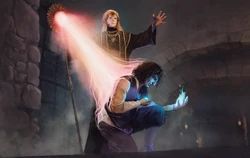Most unpredictable and difficult out of the Four Prime Elements, Fire Principle is associated with passion and power. For anyone but the most experienced magic users its use is discouraged or outright forbidden, as drawing from it is both addictive and dangerous to the mage and surroundings.
Elemental Plane of Fire

According to Nordling mages and clergy of the Immortal Ones, the Elemental Plane of Fire, also called the Dimension of Fire or the Fire Plane,[2] is a strange universe[3] that consists entirely of the Fire Principle.[4] While the Plane itself has been out of the reach of natives of the Material Plane[2] since the time of Conjunction,[3] its energy permeates the material world through ley lines.[5] The elemental Fire manifests most strongly at the intersections of ley lines,[5] which, in the physical world, occur most often in volcanic mountains or heart of the desert.[6][N 1]
Curiously enough, even mundane flames, such as those at a fireplace, seem to have a connection with the Fire Plane, allowing mages to draw Power from them.[7] This attainability comes at a price: the Fire appears to act as a conduit of Chaos, and either the Plane's residents or the Chaos itself tempt mortals,[8] particularly Sources,[9] to draw more and more Power and set the world aflame.[8] Certain religions, however, perceive Fire's might through a positive lens – the Eternal Fire clergy teaches that Fire illuminates darkness, cleanses the souls of sin, and incinerates all Evil.[7][10] Followers of the Great Sun believe that the White Flame will help defeat the White Frost.[11][5]
The Dimension of Fire is inhabited by a variety of fire elementa,[4] the most powerful of which being ifriti or afreets, the genies of Fire. When summoned to the material reality, ifriti act as living reservoirs of Fire magical energy and can create fiery columns, great fires and explosions. While records exist of powerful sorcerers having forced ifriti to serve them,[2] even less powerful fire elementals are extremely dangerous, eager to attack with scorching heat and bursts of flame.[4]
Fire magic

The Fire Principle is considered to be the most dangerous out of the Four Prime ones, even though deceivingly easy to draw from.[8][9][12] It can fuel mighty and destructive spells, and is best suited for magic that involves flames or light.[5][6][12]
Overexerting oneself while casting a Fire spell is particularly risky, and the especially unlucky caster might even involuntarily self-immolate as a result.[6] People who are Sources are particularly need to draw Fire very cautiously, as the Element is prone to trigger their innate abilities in destructive ways.[9]
Perhaps the most dangerous – both to the mage and the others – is the risk of addiction inherent to the drawing and usage of Fire, addiction capable of turning a talented sorcerer into a mad shadow of oneself. Visions of the future[7] or promises of great power[8] tempt them to draw more and more, ensnaring the untrained Fire mages and slowly changing their personality: making it harder to control themselves and their usage of Power, prone to outbursts of anger that more often than not result in striking something (or someone) with destructive spells. If not helped in time, they eventually turn into crazed, bloodthirsty monsters of men, sowing death and destruction until their own colleagues dispatch of them for good.[7] The danger inherent to Fire usage led at times to classify it as one of the forbidden arts;[13] the only Nordling sorceress known to achieve mastery over Fire rather than being mastered by Fire was Klara Larissa de Winter, the founder of the Aretuza Academy.[2][8]
Invocations and spells
For the full list of Fire-based abilities, see Category:Fire magic.
The manipulation of flames in general is called pyrokinesis,[12] whereas communing with the Element in order to reveal hidden truths is referred to as pyromancy.[6]
Igni, a weak form of pyrokinesis, is a common witcher Sign utilizing this Element.[1][10][6][12]
Gallery
Footnotes
- ↑ In Season of Storms, Geralt and Dandelion discuss Professor Lindenbrog's alternate theory, according to which elemental planes are not alternate dimensions (as explained by Krepp in The Last Wish) but building blocks of Sphera Mundi, the globe. Geralt explains that the theory is bogus, because meteorites falling on the planet's surface are not infused with the elemental energies they are supposed to pick up while falling, contradicting Lindenbrog's predictions. Later, in the same novel, Sorel Degerlund confirms that elemental and para-elemental planes are considered to be different universes.
It's possible that the Professor simply assumed that ley lines and their intersections, which infuse the world with elemental energies according to Blood of Elves and A Tome of Chaos, are the planet's natural characteristic rather than fissures leading to separate realities.
References
- ↑ 1.0 1.1 The Witcher
- ↑ 2.0 2.1 2.2 2.3 The Last Wish
- ↑ 3.0 3.1 Season of Storms
- ↑ 4.0 4.1 4.2 A Witcher's Journal
- ↑ 5.0 5.1 5.2 5.3 A Tome of Chaos
- ↑ 6.0 6.1 6.2 6.3 6.4 The Witcher Role-Playing Game
- ↑ 7.0 7.1 7.2 7.3 2nd Edition of Wiedźmin: Gra Wyobraźni
- ↑ 8.0 8.1 8.2 8.3 8.4 Time of Contempt
- ↑ 9.0 9.1 9.2 The World of the Witcher
- ↑ 10.0 10.1 The Witcher 3: Wild Hunt
- ↑ Blood of Elves
- ↑ 12.0 12.1 12.2 12.3 Wiedźmin: Gra Wyobraźni
- ↑ Netflix's The Witcher


